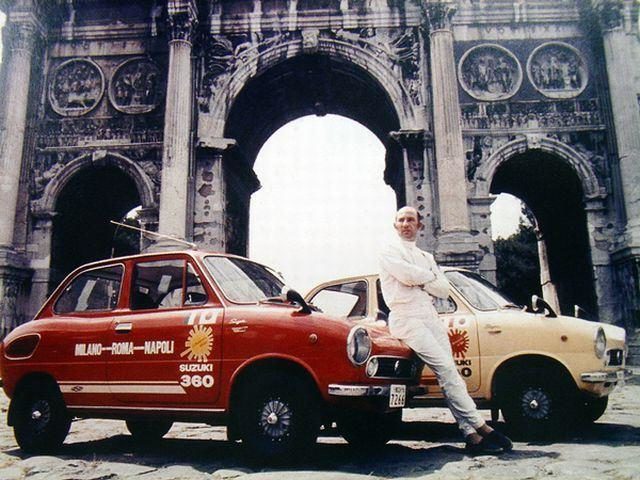In Japan there were and are all kinds of rules. That must be because the Japanese are with relatively many people on relatively little usable ground. So when Japan started motorizing, rules were soon introduced for cars such as the Suzuki Fronte described here. The Japanese had rules about engine capacity, power and dimensions. Plus the profit that early post-war Japanese were considerably smaller than Western Europeans due to a lack of dairy and McDonalds.
Suzuki and the Kei cars
The kind of cars for which the legal basis was laid in 1949 became known under the name Kei cars or 'keijidōsha' (light automobile). And those were the smallest cars that you could legally take on the highway in Japan. At first they were only allowed to have a cylinder capacity of 150 cc (which grew to 660 cc) and their power was also subject to restrictions. They were very interesting from a tax point of view and easy to park in the busy Japanese cities. In 2013, half of the cars sold in Japan consisted of these types of scale models. So the concept was a success.
The Suzuki Front
That was a car that was completely modeled on the system. The Suzuki Fronte was introduced in 1967 as a civilized version of the Suzulight Van.
The original father of the Suzuki Fronte was ... The Lloyd LP400. The Suzuki had a transversely positioned two-stroke twin in the front that powered the front wheels and independent suspension. The engine was given a separate lubrication system after just one year, so that no mixed lubrication needed to be refueled. And there was racing with the Suzuki Frontes.
In 1967 came the second generation Suzuki Fronte
The second generation Suzuki Fronte had the 360 cc three-cylinder two-stroke engine in the rear and it rolled on 10-inch wheels. Suzuki marketed the newcomer as 'the queen of Kei cars' and advertised it on TV. The plan was to make 3000 per month. But that soon became almost three times as many. That success led Suzuki to also make a version for America. But that was not successful because of 'too small'.
The Suzuki Fronte SS from 1968 delivered 27 hp and after that there was even an even sportier SSS. Suzuki hired none other than Stirling Moss and the TT winner Mitsuo Itoh for a ride from Milan to Naples. About the motorway. The average speed on that route was 122,44 km / h.
The 475 cc, 29 pk export version saw the light in 1969
In that year, the Suzuki Fronte also received a facelift. In April he got another one. And in 1970 it was time for the third generation Frontes. He had - for what it is worth with such a young man - an 'aggressive' styling that became known as the 'Stingray' styling. Something that the General Motors had to laugh about.
In terms of type designations, the Japanese also got loose: above the basic version of the Suzuki Fronte were the 'S', the 'SS', the 'SSS' and the 'SSS-R'. The 'R' was the indication that the Suzuki had radial tires. In 1970 the letter 'W' was added. It stood for water cooling.
1971 Was the year of the Suzuki Fronte Coupé signed by Giugiaro
The two-seater was equipped with the liquid-cooled 'W' power source. In 1973 there was the Suzuki Fronte LC20 with a whole new line pattern. It got a 2 cm larger wheelbase, but the dimensions remained 1995 x 1295 mm to stay within the Keicar regulations. But within those measures there was still the possibility to present a four-door Fronte. Suzuki made the distinction in offer clear: the types available were the two-door GU, GD, GH, GC, GT, GT type II and the four-door FU, FD, FH, FC, FT models.
In the meantime, the government made plans to limit urban air pollution by amending the Kei car law so that a maximum of 550 cc large four-stroke engines would help clear the air. And so came in 1976 the Suzuki Fronte 7-S. And what did the seven 'Ssen' stand for? Of course for Space, Safety, Sense, Save money, Silent, Stamina, and Suzuki TC. Clearly.
Because Suzuki no longer got its own two-stroke engines in 1978 due to the emissions tests, it was time for a smart plan. Or an emergency handle. Suzuki signed a contract with Toyota to buy Daihatsu blocks. Those dwarfs with an '4' in the grille were no sales success. The two-stroke had considerably more pleasant engine character.
The further developments of the Suzuki Front?
We will come back to that again. But we have at least been surprised by the wonderful world of Kei cars. And the 'trigger' in this case was the brochure material that the now retired car editor Ted Sluymer is putting on his Facebook page. We also have an impressive archive, the digitization of which does not want to get started due to the daily bustle. So we once again dived into that.
And it's great to dive into our gray cabinets. Because there is so much more than Rollsen, Mercedes and Citroëns. And even those brands have made a lot that is actually forgotten. For example, I have a press file about the Citroen 3CV ... Ever heard of it?





Seems to me it's Ted Sluymer. This is disrespectful and really messy.
It has been corrected. But if a mistake is disrespectful, then this world is lost